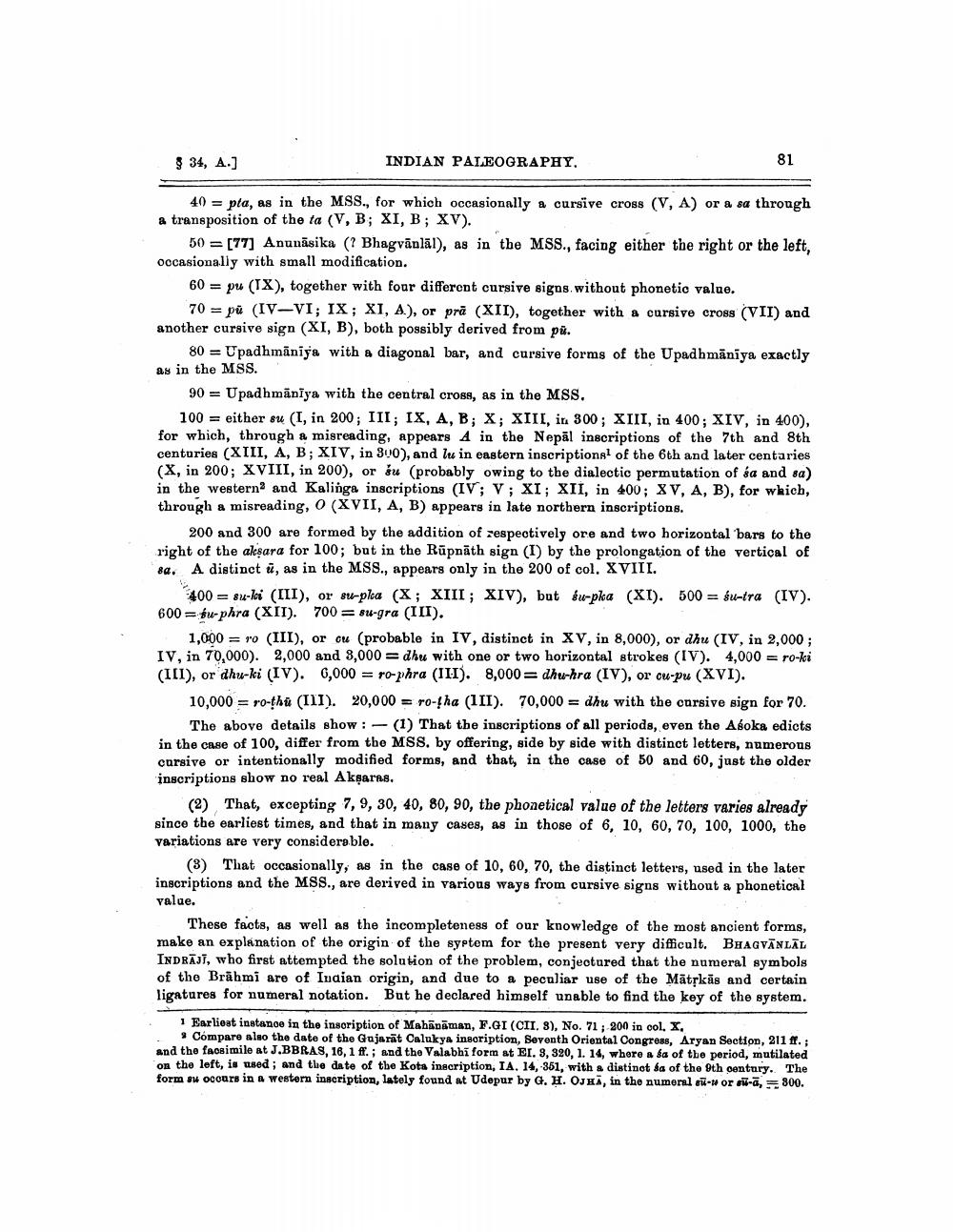________________
INDIAN PALEOGRAPHY.
81
§ 34, A.]
40 pta, as in the MSS., for which occasionally a cursive cross (V, A) or a sa through a transposition of the ta (V, B; XI, B; XV).
50 [77] Anunāsika (? Bhagvanlal), as in the MSS., facing either the right or the left, occasionally with small modification.
60 pu (TX), together with four different cursive signs. without phonetic value.
70 pu (IV-VI; IX; XI, A), or pra (XII), together with a cursive cross (VII) and another cursive sign (XI, B), both possibly derived from pu.
80 Upadhmaniya with a diagonal bar, and cursive forms of the Upadhmaniya exactly as in the MSS.
90
Upadhmaniya with the central cross, as in the MSS.
100 either su (I, in 200; III; IX, A, B; X; XIII, in 300; XIII, in 400; XIV, in 400), for which, through a misreading, appears A in the Nepal inscriptions of the 7th and 8th centuries (XIII, A, B; XIV, in 300), and lu in eastern inscriptions1 of the 6th and later centuries (X, in 200; XVIII, in 200), or u (probably owing to the dialectic permutation of sa and sa) in the western and Kalinga inscriptions (IV; V; XI; XII, in 400; XV, A, B), for which, through a misreading, O (XVII, A, B) appears in late northern inscriptions.
200 and 300 are formed by the addition of respectively ore and two horizontal bars to the right of the aksara for 100; but in the Rupnath sign (I) by the prolongation of the vertical of sa. A distinct u, as in the MSS., appears only in the 200 of col. XVIII.
400 su-ki (III), or su-pka (X; XIII; XIV), but su-pka (XI). 500 śu-tra (IV). 600bu-phra (XII). 700 su-gra (III).
1,000 = ro (III), or cu (probable in IV, distinct in XV, in 8,000), or dhu (IV, in 2,000; IV, in 70,000). 2,000 and 3,000=dhu with one or two horizontal strokes (IV). 4,000 ro-ki (III), or dhu-ki (IV). 6,000 ro-phra (III). 8,000 dhu-hra (IV), or cu-pu (XVI).
ro-tha (111). 70,000
The above details show:
10,000 ro-thu (III). 20,000 dhu with the cursive sign for 70. (1) That the inscriptions of all periods, even the Aśoka edicts in the case of 100, differ from the MSS. by offering, side by side with distinct letters, numerous cursive or intentionally modified forms, and that, in the case of 50 and 60, just the older inscriptions show no real Aksaras.
(2) That, excepting 7, 9, 30, 40, 80, 90, the phonetical value of the letters varies already since the earliest times, and that in many cases, as in those of 6, 10, 60, 70, 100, 1000, the variations are very considerable.
(3) That occasionally, as in the case of 10, 60, 70, the distinct letters, used in the later inscriptions and the MSS., are derived in various ways from cursive signs without a phonetical value.
These facts, as well as the incompleteness of our knowledge of the most ancient forms, make an explanation of the origin of the system for the present very difficult. BHAGVANLAL INDRAJI, who first attempted the solution of the problem, conjectured that the numeral symbols of the Brahmi are of Indian origin, and due to a peculiar use of the Matṛkās and certain ligatures for numeral notation. But he declared himself unable to find the key of the system.
1 Earliest instance in the inscription of Mahanaman, F.GI (CII. 3), No. 71; 200 in col. X.
9 Cómpare also the date of the Gujarat Calukya inscription, Seventh Oriental Congress, Aryan Section, 211 ff.; and the facsimile at J.BBRAS, 16, 1 ff.; and the Valabhi form at EI. 3, 320, 1. 14, where a sa of the period, mutilated on the left, is used; and the date of the Kota inscription, IA. 14, 351, with a distinct sa of the 9th century. The form su occurs in a western inscription, lately found at Udepur by G. H. OJHA, in the numeral su- or su-a, 800.




